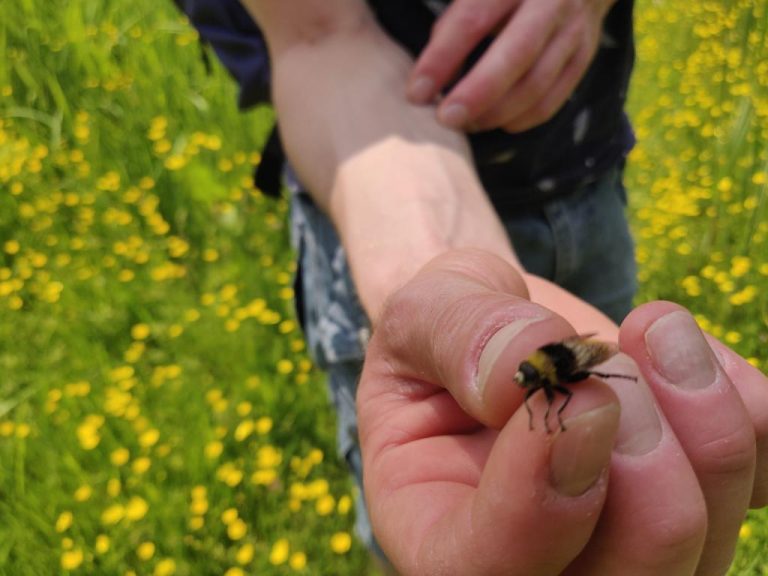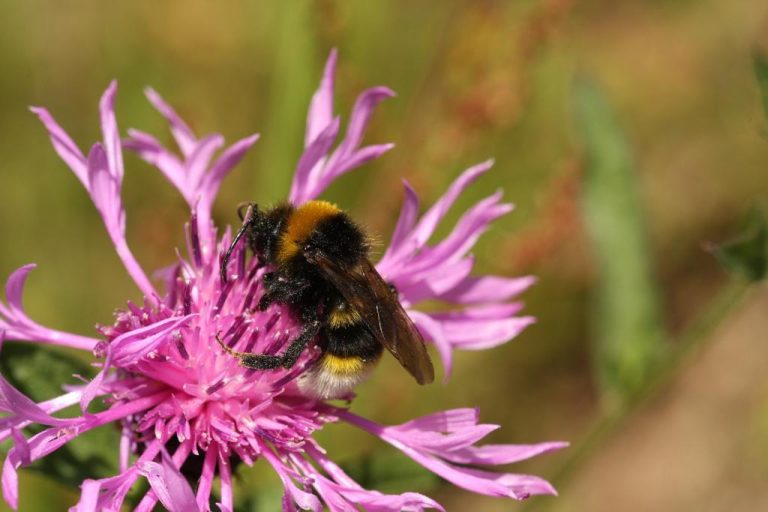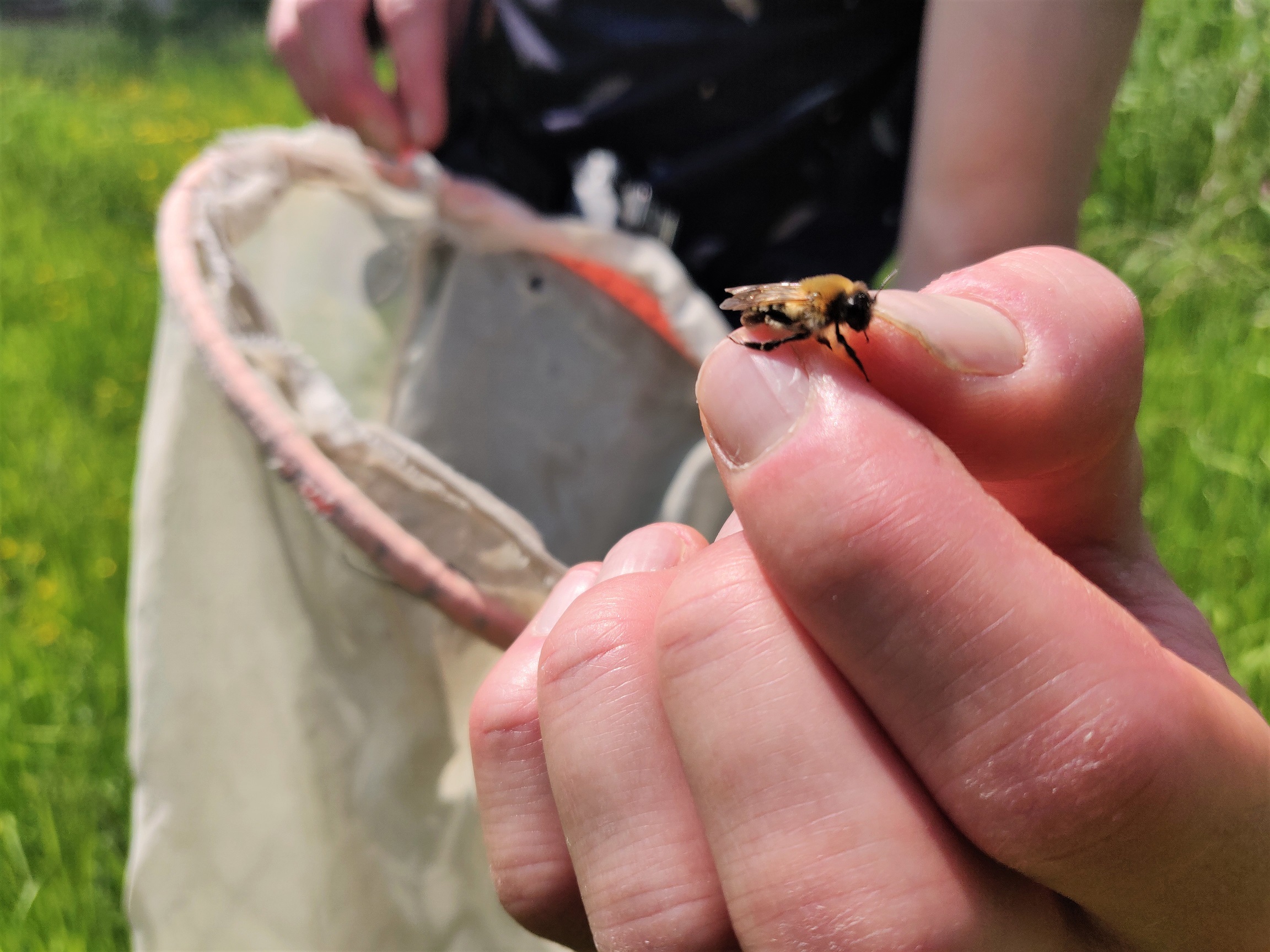In his search for wild bees on campus, alumnus Dominic Dijkshoorn found more than 40 different species. Delta went with him and immediately spotted a rare species.
Dominic Dijkshoorn observes wild bees on TU Delft campus. (Photos: Marjolein van der Veldt)
With a butterfly net in his hand and a camera around his neck, bee spotter and mechanical engineer Dominic Dijkshoorn himself was easy to spot when we meet up with him at the Hammenpoort in the natural playground behind the Duwo complex on Leeghwaterstraat.
Dijkshoorn has observed wild bees on campus for the last five years during his Mechanical Engineering study. He found more than 40 species, among which are five rare species. And that number is growing as more flowers are appearing on campus which are attracting more bees. “I really enjoy this,” he says with great passion, “but most people haven’t a clue.” On this summery day he led Delta around the campus, along unexpected places and plants, and showed us the TU Delft grounds with different eyes.
Old and worn out female
When we walk into the natural playground on the shell footpath, Dijkshoorn quickly stops. He stares fixedly at a clump of cow parsley, takes his net and scoops a bee with unrivalled ease.


“This is a female yellow-legged mining bee,” he says while checking that the bee really is in the net. “Mining bees fly from early spring to the end of summer.” According to Dijkshoorn, it is an old and worn out female. “You can see this by her grey and frayed hair. Normally female mining bees are recognisable by their clear creamy white bands of hair on their backs.”
He holds the bee between his thumb and index finger. How often has he been stung in all these years? “A few times,” he laughs. “But only female bees have a sting and thus can sting. If you can distinguish the male bees, the chance of being stung is far smaller. And while several bee species have a sting, they cannot penetrate through our skin. This is the case with this mining bee.”
‘The females have a nasty sting’
Holding it looks uncomfortable for the bee but Dijkshoorn says that bees are tough creatures. “They are strong and you can hold them carefully by several legs.” He does admit that this does not always go well, though. “I’ve been mistaken a couple of times and have held a female worker bumblebee that I thought was a male. Those females really have a nasty sting!”
Pine cones on the windowsill
As we walk on, Dijkshoorn tells us that he started developing a passion for flora and fauna at an early age. “When I was on holiday with my parents, I took a couple of pine cones and dried them on the windowsill.” He then shook out the seeds. The seedlings ended up in family’s and friends’ gardens. Some grew into trees that are still standing.
After a Nederlandse Jeugdbond voor Natuurstudie (NJN, Netherlands youth society for the study of nature) summer camp in Overijssel – where he looked for rare dragonflies in the marsh – the floodgates really opened. “From then on, I immersed myself in nature.”
His interest in wild bees grew in 2015 and when the book Nederlandse bijen op naam brengen – deel 1 (Identifying Dutch bees – part 1) was published in 2016, he decided to get involved in publishing (in Dutch) the second part. The book was published at the end of 2020 and covers the ‘second half’ of all bee species in the Netherlands. There are 367 known species of wild bees in the Netherlands, a few dozen of which can be found on campus. Dijkshoorn stresses that “the honey bee is not classified as a wild bee. Honey bees live in apiaries and are taken care of by beekeepers and they are cultivated animals.”
Catching
Dijkshoorn records his observations in a website (click on EN for the English language version) in as much detail as he can. He notes any important features of the bee, if he can he takes a photo, and notes the location, date and time.
Spotting bees is a question of “a lot of practice”, he says. “You first learn where to find bees – mostly close to flowering plants – and then check if it is a bee and not a wasp or a hoverfly that closely resemble bees. You then try to catch the bee with a net or a jar to examine it closely. This went wrong hundreds of times, but after a lot of practice, I can now manage it pretty well.”
A lot of hoverflies look like bees
Determining the species is a mammoth task as a lot of hoverflies look like bees. “It’s a natural defence mechanism,” explains Dijkshoorn. “As they resemble stinging bees, they avoid becoming prey.” This defence mechanism works well as for us beginners, the hoverfly below looked exactly like a bumblebee.


We walk on and turn towards a field where we need to watch our step because of the abundant thistles and stinging nettles. There is a small ditch to the right where little seems to be happening at first sight. Dijkshoorn points to a striking purple flower. “The leopard marsh orchid. Isn’t it amazing that orchids grow here on campus?”


Bee hotel
After meeting several bee species close up, we walk back to the main path. Dijkshoorn points out the route to the bee hotel made of pruned branches from his landlord’s garden.
Males fly back and forth looking for females to mate with, while female red mason bees – named for their gingery red bodies – scoot in and out of the holes.
From the bee hotel, the path leads across rickety wooden bridges soon to be replaced by the campus landscape managers, to the other side of the natural playground. Dijkshoorn points to several plants and then suddenly he spots a rare species. He takes his net and catches a large male vestal cuckoo bumblebee. This is a first as he has not yet seen this species on campus.


The woods back to campus
After this special discovery, we get back on our bikes and cycle along a narrow path through the woods along the Kruithuisweg. There are a lot of bees in this part of the woods. They fly along the footpath, the edge of the woods and in open spaces. The woods were planted in 1970 and in some places there are herbs such as wild garlic and avens, and one large rare European white elm.
At the end of the path we turn right and head towards TNW Zuid (Faculty of Applied Sciences). Behind the building is a field of various species of clover and lathyrus. “Important plants for bees,” says Dijkshoorn. If you did not know that it is buzzing with life here, you would just walk by. Dijkshoorn does not walk by and instead points to the bee orchid. “A beautiful flower that looks like a bee. The bee orchid is pollinated by a special species, one of the long-horned bees.


Hiding
Our penultimate stop is the pond between the Faculties of Electrical Engineering, Mathematics and Computer Science and Mechanical, Maritime and Materials Engineering. We look across to the office of the Executive Board, and work our way through tall reed. Dijkshoorn explains that years ago this place was full of two species of marsh orchids, “but I don’t see any anymore”. Somewhat disappointed we move on until we suddenly see a purple head peeping out from among other plants. Dijkshoorn confirms it. “The leopard marsh orchid!” he calls out enthusiastically.
‘I’m far from finished with counting bees’
Delighted we cycle to our last stop, the water opposite the Faculty of Technology, Policy and Management. In summer, purple loosestrife and yellow loosestrife grow along the water. “Wild flowers and typical waterside plants that attract a particular bee for pollination – the Melitta nigricans and the Macropis europaea.” When Dijkshoorn went looking for the Melitta nigricans in the summer of 2020, this species had only been seen in one location in Delft up to then. “But I found several male Purple-loosestrife Bee and the Yellow-loosestrife Bee.”
Even though Dijkshoorn has graduated, he is not planning to stop bee spotting on TU Delft’s grounds for the time being. “Luckily I work on campus as I’m far from finished with counting bees.”


- Do you want to know the species of wild bee on campus? Dominic Dijkshoorn records his observations in the waarneming.nl website where the newly found large male vestal cuckoo bumblebee is registered.
- For more information about wild bees, visit Wilde Bijen (in Dutch).
Do you have a question or comment about this article?
m.vanderveldt@tudelft.nl


Comments are closed.